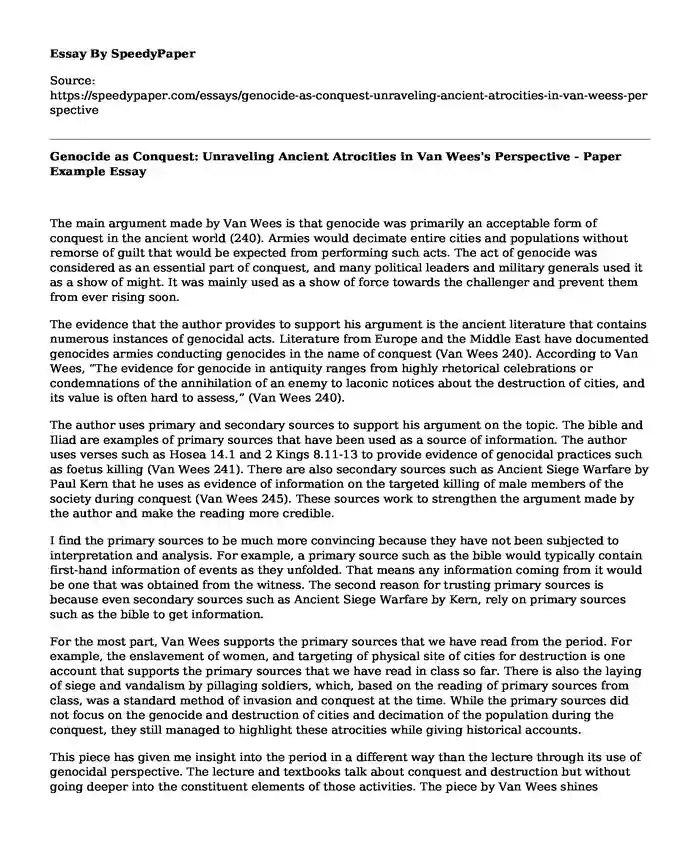The main argument made by Van Wees is that genocide was primarily an acceptable form of conquest in the ancient world (240). Armies would decimate entire cities and populations without remorse of guilt that would be expected from performing such acts. The act of genocide was considered as an essential part of conquest, and many political leaders and military generals used it as a show of might. It was mainly used as a show of force towards the challenger and prevent them from ever rising soon.
The evidence that the author provides to support his argument is the ancient literature that contains numerous instances of genocidal acts. Literature from Europe and the Middle East have documented genocides armies conducting genocides in the name of conquest (Van Wees 240). According to Van Wees, “The evidence for genocide in antiquity ranges from highly rhetorical celebrations or condemnations of the annihilation of an enemy to laconic notices about the destruction of cities, and its value is often hard to assess,” (Van Wees 240).
The author uses primary and secondary sources to support his argument on the topic. The bible and Iliad are examples of primary sources that have been used as a source of information. The author uses verses such as Hosea 14.1 and 2 Kings 8.11-13 to provide evidence of genocidal practices such as foetus killing (Van Wees 241). There are also secondary sources such as Ancient Siege Warfare by Paul Kern that he uses as evidence of information on the targeted killing of male members of the society during conquest (Van Wees 245). These sources work to strengthen the argument made by the author and make the reading more credible.
I find the primary sources to be much more convincing because they have not been subjected to interpretation and analysis. For example, a primary source such as the bible would typically contain first-hand information of events as they unfolded. That means any information coming from it would be one that was obtained from the witness. The second reason for trusting primary sources is because even secondary sources such as Ancient Siege Warfare by Kern, rely on primary sources such as the bible to get information.
For the most part, Van Wees supports the primary sources that we have read from the period. For example, the enslavement of women, and targeting of physical site of cities for destruction is one account that supports the primary sources that we have read in class so far. There is also the laying of siege and vandalism by pillaging soldiers, which, based on the reading of primary sources from class, was a standard method of invasion and conquest at the time. While the primary sources did not focus on the genocide and destruction of cities and decimation of the population during the conquest, they still managed to highlight these atrocities while giving historical accounts.
This piece has given me insight into the period in a different way than the lecture through its use of genocidal perspective. The lecture and textbooks talk about conquest and destruction but without going deeper into the constituent elements of those activities. The piece by Van Wees shines analyses the individual actions involved in conquest and destruction and how they constitute genocide. The activities that were considered as standard procedure in conquest, such as targeted killings, cutting open pregnant women and enslavement would qualify as war crimes in the modern period. They would be categorized as genocide.
Works Cited
Van Wees, Hans. "Genocide in the ancient world." The Oxford handbook of genocide studies. 2010.
Cite this page
Genocide as Conquest: Unraveling Ancient Atrocities in Van Wees's Perspective - Paper Example. (2023, Dec 30). Retrieved from https://speedypaper.com/essays/genocide-as-conquest-unraveling-ancient-atrocities-in-van-weess-perspective
Request Removal
If you are the original author of this essay and no longer wish to have it published on the SpeedyPaper website, please click below to request its removal:
- Free Essay Dedicated to Industrialization in England
- Free Essay Example on the Literature of Enlightenment
- Essay Example: The Anti-War Movement in the 1960s-1970s the U. S.
- Essay Example on Liberty Equity and Power
- Free Essay. George Washington Farewell Address
- Essay Sample on Greek Idealism vs. Roman Idealism
- Echoes of Darkness: Unveiling Parallels in the Armenian Genocide and the Holocaust
Popular categories





